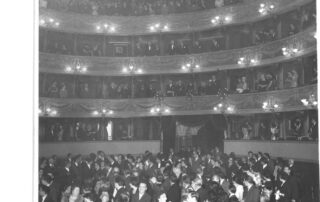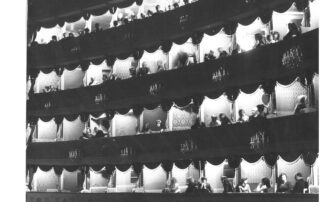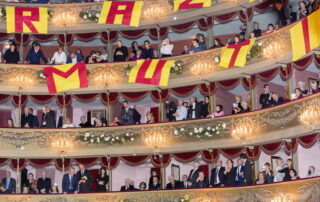From the end of the 18th century and up until the early 20th century, owning a box in a theatre was a sign of distinction. It happened here in Bergamo just like in Milan, at the La Scala theater: going to a performance meant meeting other noble or wealthy families. All the well-off people in Bergamo came here to meet friends, acquaintances and various personalities. It was the perfect occasion to catch up on conversations and debates that had started in palaces or anywhere else. The price of a theatre box and the prestige attached to it were defined by its position: the central boxes of the first and second floor were the most important ones. Owning a box meant having a private space, to welcome guests and to enjoy the shows with your family or your loved ones.
A small dressing room preceded the actual box, and this is where the waiters prepared the food. When the curtains were drawn, this space became private and was suitable for private meetings as well as official gatherings.
Buying a box meant making a great investment, but the property remained to the family who had bought it. Even today, the old owners have privileged rights forpurchasing tickets.
Sitting in the boxes in the old days was like attenting a party, to watch the others and to be watched. Most importantly, to be here. My boxes have always been owned: in the early days Bortolo Riccardi sold them out to make profits and the buyers were all from the wealthier families, such as the Scottis, the Suardos, the Camozzis, the Veniers.
The property of the boxes has changed over time, in line with the property of the theatre itself. In 1938 I was acquired by the Municipality of Bergamo, but not all the boxes became public property. Some of them are private still today, but they can be used by everybody. Each box reminds me of its owners and recalls a number of stories.
One of the most important guests the Theater had: in 2016 the President of the Italian Republic Sergio Mattarella came to celebrate conductor Riccardo Muti and its 50 years of activity.
In 1840 Gaetano Donizetti was acclaimed and celebrated by the whole town for L’Esule di Roma. And next to him was his master, Simone Mayr.
So many great events, but also little moments: gossiping, criticizing and also flirting, accompanied by sweet hand kisses and passionate looks.
CORNER TO DISCOVER
The Queens parlor
This room is dedicated to two great queens: Anne Boleyn and Mary Stuart, the protagonists of two masterpieces by Gaetano Donizetti here celebrated by two historic posters. The queens are unforgettable characters, both bright and strong, and they perfectly portray these two women who made history and truly changed their times. The two armchairs that you can see here come from two boxes.
The mirror gallery
These mirrors make such a breathtaking effect: shapes and objects are multiplied. The mirrors come from the private boxes, they were brought in by the owners and were gradually passed onto the Municipality that acquired them. The last box owners decided to leave all their furniture when the theater was last restored.
The mirrors come in all different shapes since, in the past, the box owners were free to give their own touch to their private space. Over the decades, a decision was made to have all the boxes look alike, as in other theaters.





